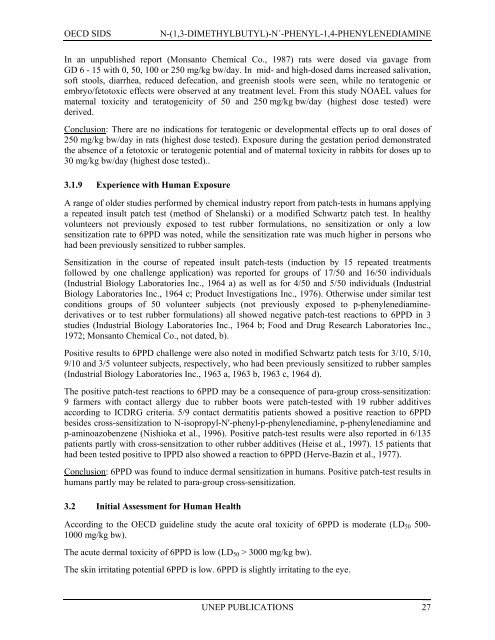N-(1,3-Dimethylbutyl)-N
N-(1,3-Dimethylbutyl)-N
N-(1,3-Dimethylbutyl)-N
Create successful ePaper yourself
Turn your PDF publications into a flip-book with our unique Google optimized e-Paper software.
OECD SIDS<br />
N-(1,3-DIMETHYLBUTYL)-N´-PHENYL-1,4-PHENYLENEDIAMINE<br />
In an unpublished report (Monsanto Chemical Co., 1987) rats were dosed via gavage from<br />
GD 6 - 15 with 0, 50, 100 or 250 mg/kg bw/day. In mid- and high-dosed dams increased salivation,<br />
soft stools, diarrhea, reduced defecation, and greenish stools were seen, while no teratogenic or<br />
embryo/fetotoxic effects were observed at any treatment level. From this study NOAEL values for<br />
maternal toxicity and teratogenicity of 50 and 250 mg/kg bw/day (highest dose tested) were<br />
derived.<br />
Conclusion: There are no indications for teratogenic or developmental effects up to oral doses of<br />
250 mg/kg bw/day in rats (highest dose tested). Exposure during the gestation period demonstrated<br />
the absence of a fetotoxic or teratogenic potential and of maternal toxicity in rabbits for doses up to<br />
30 mg/kg bw/day (highest dose tested)..<br />
3.1.9 Experience with Human Exposure<br />
A range of older studies performed by chemical industry report from patch-tests in humans applying<br />
a repeated insult patch test (method of Shelanski) or a modified Schwartz patch test. In healthy<br />
volunteers not previously exposed to test rubber formulations, no sensitization or only a low<br />
sensitization rate to 6PPD was noted, while the sensitization rate was much higher in persons who<br />
had been previously sensitized to rubber samples.<br />
Sensitization in the course of repeated insult patch-tests (induction by 15 repeated treatments<br />
followed by one challenge application) was reported for groups of 17/50 and 16/50 individuals<br />
(Industrial Biology Laboratories Inc., 1964 a) as well as for 4/50 and 5/50 individuals (Industrial<br />
Biology Laboratories Inc., 1964 c; Product Investigations Inc., 1976). Otherwise under similar test<br />
conditions groups of 50 volunteer subjects (not previously exposed to p-phenylenediaminederivatives<br />
or to test rubber formulations) all showed negative patch-test reactions to 6PPD in 3<br />
studies (Industrial Biology Laboratories Inc., 1964 b; Food and Drug Research Laboratories Inc.,<br />
1972; Monsanto Chemical Co., not dated, b).<br />
Positive results to 6PPD challenge were also noted in modified Schwartz patch tests for 3/10, 5/10,<br />
9/10 and 3/5 volunteer subjects, respectively, who had been previously sensitized to rubber samples<br />
(Industrial Biology Laboratories Inc., 1963 a, 1963 b, 1963 c, 1964 d).<br />
The positive patch-test reactions to 6PPD may be a consequence of para-group cross-sensitization:<br />
9 farmers with contact allergy due to rubber boots were patch-tested with 19 rubber additives<br />
according to ICDRG criteria. 5/9 contact dermatitis patients showed a positive reaction to 6PPD<br />
besides cross-sensitization to N-isopropyl-N'-phenyl-p-phenylenediamine, p-phenylenediamine and<br />
p-aminoazobenzene (Nishioka et al., 1996). Positive patch-test results were also reported in 6/135<br />
patients partly with cross-sensitzation to other rubber additives (Heise et al., 1997). 15 patients that<br />
had been tested positive to IPPD also showed a reaction to 6PPD (Herve-Bazin et al., 1977).<br />
Conclusion: 6PPD was found to induce dermal sensitization in humans. Positive patch-test results in<br />
humans partly may be related to para-group cross-sensitization.<br />
3.2 Initial Assessment for Human Health<br />
According to the OECD guideline study the acute oral toxicity of 6PPD is moderate (LD 50 500-<br />
1000 mg/kg bw).<br />
The acute dermal toxicity of 6PPD is low (LD 50 > 3000 mg/kg bw).<br />
The skin irritating potential 6PPD is low. 6PPD is slightly irritating to the eye.<br />
UNEP PUBLICATIONS 27
















